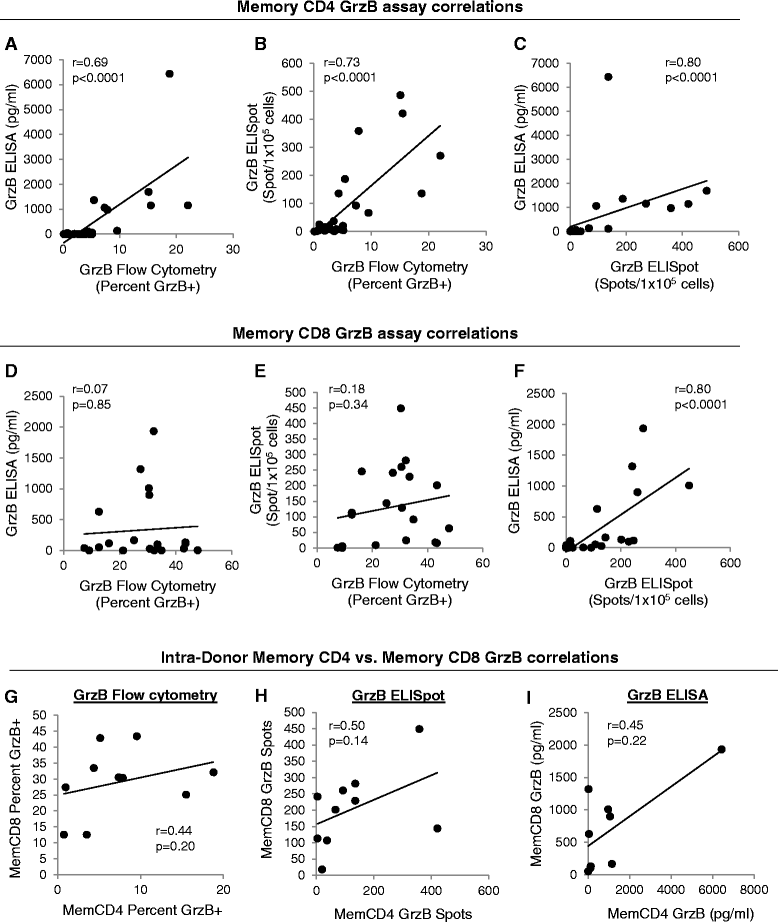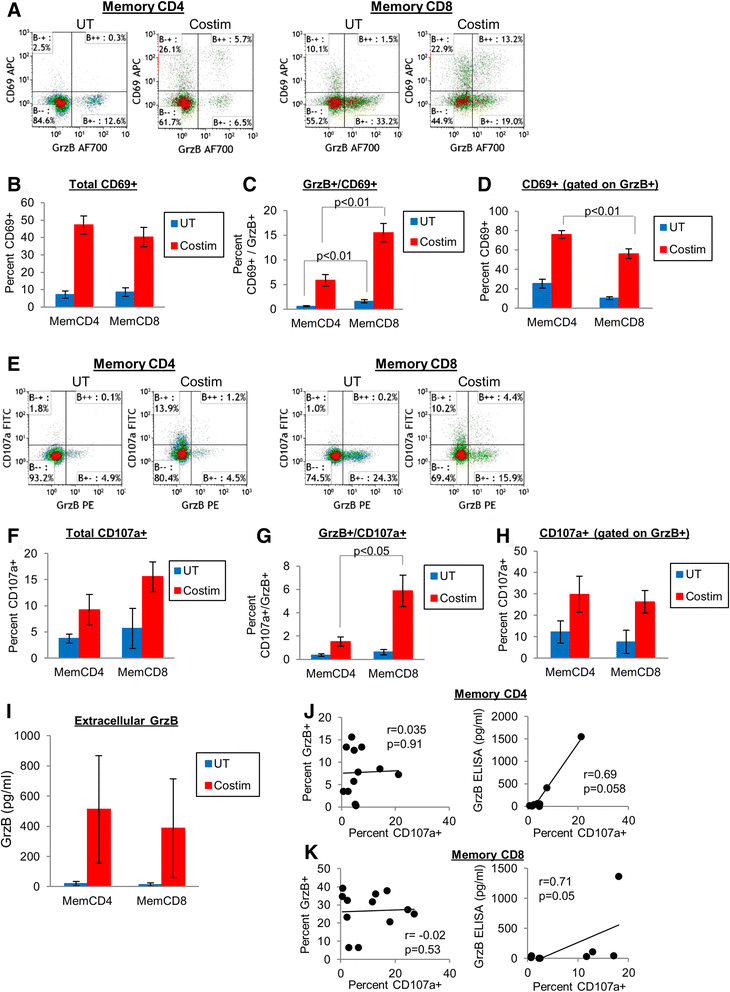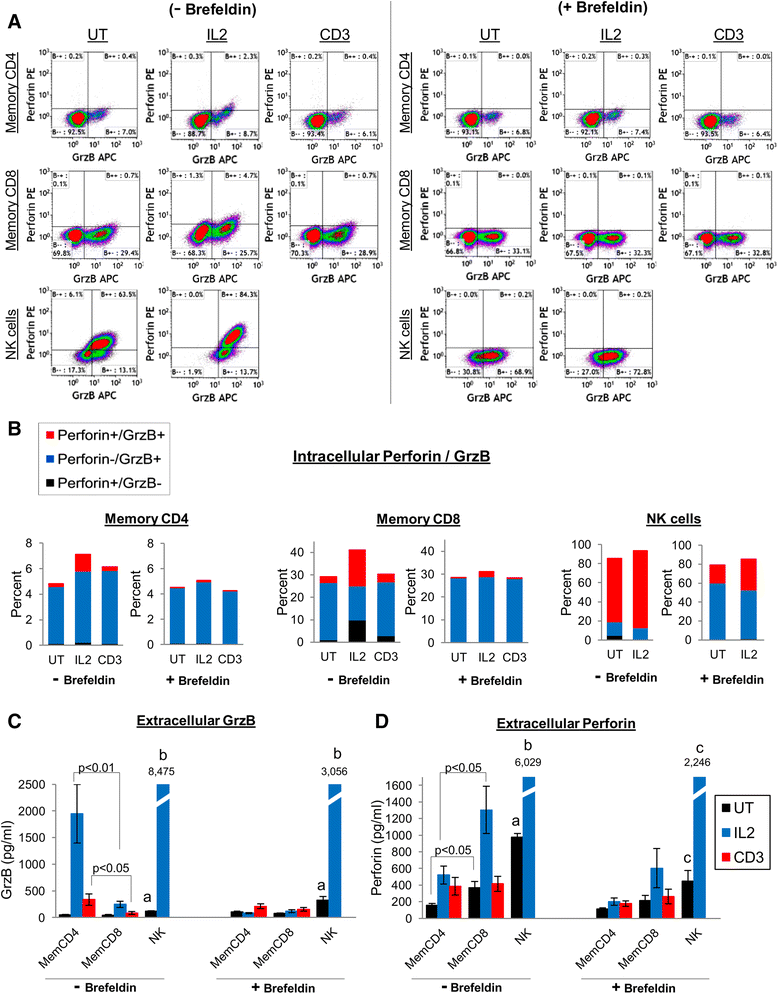Granzyme B secretion by human memory CD4 T cells is less strictly regulated compared to memory CD8 T cells
- PMID: 25245659
- PMCID: PMC4195902
- DOI: 10.1186/s12865-014-0036-1
Granzyme B secretion by human memory CD4 T cells is less strictly regulated compared to memory CD8 T cells
Abstract
Background: Granzyme B (GrzB) is a serine proteinase expressed by memory T cells and NK cells. Methods to measure GrzB protein usually involve intracellular (flow cytometry) and extracellular (ELISA and ELISpot) assays. CD8 T cells are the main source of GrzB during immunological reactions, but activated CD4 T cells deploy GrzB as well. Because GrzB is an important mediator of cell death, tissue pathology and disease, clarification of differences of GrzB expression and secretion between CD4 and CD8 T cells is important for understanding effector functions of these cells.
Results: Memory CD4 and memory CD8 T cells were purified from human peripheral blood of healthy donors, and production of GrzB was directly compared between memory CD4 and memory CD8 T cells from the same donors using parallel measurements of flow cytometry (intracellular GrzB), ELISpot (single cell secretion of GrzB), and ELISA (bulk extracellular GrzB). Memory CD8 T cells constitutively stored significantly more GrzB protein (~25%) compared to memory CD4 T cells as determined by flow cytometry (~3%), and this difference remained stable after 24 hrs of activation. However, measurement of extracellular GrzB by ELISA revealed that activated memory CD4 T cells secrete similar amounts of GrzB (~1,000 pg/ml by 1x10(5) cells/200 μl medium) compared to memory CD8 T cells (~600 pg/ml). Measurement of individual GrzB-secreting cells by ELISpot also indicated that similar numbers of activated memory CD4 (~170/1x10(5)) and memory CD8 (~200/1x10(5)) T cells secreted GrzB. Expression of CD107a further indicated that Grzb is secreted similarly by activated CD4 and CD8 T cells, consistent with the ELISA and ELISpot results. However, memory CD8 T cells expressed and secreted more perforin compared to memory CD4 T cells, suggesting that perforin may be less associated with GrzB function for memory CD4 T cells.
Conclusions: Although measurement of intracellular GrzB by flow cytometry suggests that a larger proportion of CD8 T cells have higher capacity for GrzB production compared to CD4 T cells, ELISpot and ELISA show that similar numbers of activated CD4 and CD8 T cells secrete similar amounts of GrzB. Secretion of GrzB by activated CD8 T cells may be more tightly controlled compared to CD4 T cells.
Figures





Similar articles
-
The major CD8 T cell effector memory subset in the normal and Chlamydia trachomatis-infected human endocervix is low in perforin.BMC Immunol. 2012 Dec 7;13:66. doi: 10.1186/1471-2172-13-66. BMC Immunol. 2012. PMID: 23216954 Free PMC article.
-
HIV replication in conjunction with granzyme B production by CCR5+ memory CD4 T cells: Implications for bystander cell and tissue pathologies.Virology. 2014 Aug;462-463:175-88. doi: 10.1016/j.virol.2014.06.008. Epub 2014 Jul 4. Virology. 2014. PMID: 24999042 Free PMC article.
-
Lung cancer is associated with decreased expression of perforin, granzyme B and interferon (IFN)-γ by infiltrating lung tissue T cells, natural killer (NK) T-like and NK cells.Clin Exp Immunol. 2014 Oct;178(1):79-85. doi: 10.1111/cei.12392. Clin Exp Immunol. 2014. PMID: 24894428 Free PMC article.
-
Molecular characterization of HCMV-specific immune responses: Parallels between CD8(+) T cells, CD4(+) T cells, and NK cells.Eur J Immunol. 2015 Sep;45(9):2433-45. doi: 10.1002/eji.201545495. Epub 2015 Aug 24. Eur J Immunol. 2015. PMID: 26228786 Review.
-
T cells at work: How post-transcriptional mechanisms control T cell homeostasis and activation.Eur J Immunol. 2021 Sep;51(9):2178-2187. doi: 10.1002/eji.202049055. Epub 2021 Jul 14. Eur J Immunol. 2021. PMID: 34180545 Free PMC article. Review.
Cited by
-
Potency assessment of IFNγ-producing SARS-CoV-2-specific T cells from COVID-19 convalescent subjects.Life Sci Alliance. 2023 Mar 20;6(6):e202201759. doi: 10.26508/lsa.202201759. Print 2023 Jun. Life Sci Alliance. 2023. PMID: 36941056 Free PMC article.
-
Analysis of Immune Landscape Reveals Prognostic Significance of Cytotoxic CD4+ T Cells in the Central Region of pMMR CRC.Front Oncol. 2021 Sep 22;11:724232. doi: 10.3389/fonc.2021.724232. eCollection 2021. Front Oncol. 2021. PMID: 34631551 Free PMC article.
-
Mucosal IL-4R antagonist HIV vaccination with SOSIP-gp140 booster can induce high-quality cytotoxic CD4+/CD8+ T cells and humoral responses in macaques.Sci Rep. 2020 Dec 16;10(1):22077. doi: 10.1038/s41598-020-79172-7. Sci Rep. 2020. PMID: 33328567 Free PMC article.
-
A design and optimization of a high throughput valve based microfluidic device for single cell compartmentalization and analysis.Sci Rep. 2021 Jun 21;11(1):12995. doi: 10.1038/s41598-021-92472-w. Sci Rep. 2021. PMID: 34155296 Free PMC article.
-
Granzyme B-activated IL18 potentiates αβ and γδ CAR T cell immunotherapy in a tumor-dependent manner.Mol Ther. 2024 Jul 3;32(7):2373-2392. doi: 10.1016/j.ymthe.2024.05.013. Epub 2024 May 14. Mol Ther. 2024. PMID: 38745414 Free PMC article.
References
-
- Strik MC, de Koning PJ, Kleijmeer MJ, Bladergroen BA, Wolbink AM, Griffith JM, Wouters D, Fukuoka Y, Schwartz LB, Hack CE, van Ham SM, Kummer JA. Human mast cells produce and release the cytotoxic lymphocyte associated protease granzyme B upon activation. Mol Immunol. 2007;44(14):3462–3472. doi: 10.1016/j.molimm.2007.03.024. - DOI - PubMed
-
- Hagn M, Schwesinger E, Ebel V, Sontheimer K, Maier J, Beyer T, Syrovets T, Laumonnier Y, Fabricius D, Simmet T, Jahrsdörfer B. Human B cells secrete granzyme B when recognizing viral antigens in the context of the acute phase cytokine IL-21. J Immunol. 2009;183(3):1838–1845. doi: 10.4049/jimmunol.0901066. - DOI - PubMed
-
- Jahrsdörfer B, Vollmer A, Blackwell SE, Maier J, Sontheimer K, Beyer T, Mandel B, Lunov O, Tron K, Nienhaus GU, Simmet T, Debatin KM, Weiner GJ, Fabricius D. Granzyme B produced by human plasmacytoid dendritic cells suppresses T-cell expansion. Blood. 2010;115(6):1156–1165. doi: 10.1182/blood-2009-07-235382. - DOI - PMC - PubMed
-
- Karrich JJ, Jachimowski LC, Nagasawa M, Kamp A, Balzarolo M, Wolkers MC, Uittenbogaart CH, Marieke van Ham S, Blom B. IL-21-stimulated human plasmacytoid dendritic cells secrete granzyme B, which impairs their capacity to induce T-cell proliferation. Blood. 2013;121(16):3103–3111. doi: 10.1182/blood-2012-08-452995. - DOI - PMC - PubMed
Publication types
MeSH terms
Substances
Grants and funding
LinkOut - more resources
Full Text Sources
Other Literature Sources
Research Materials

